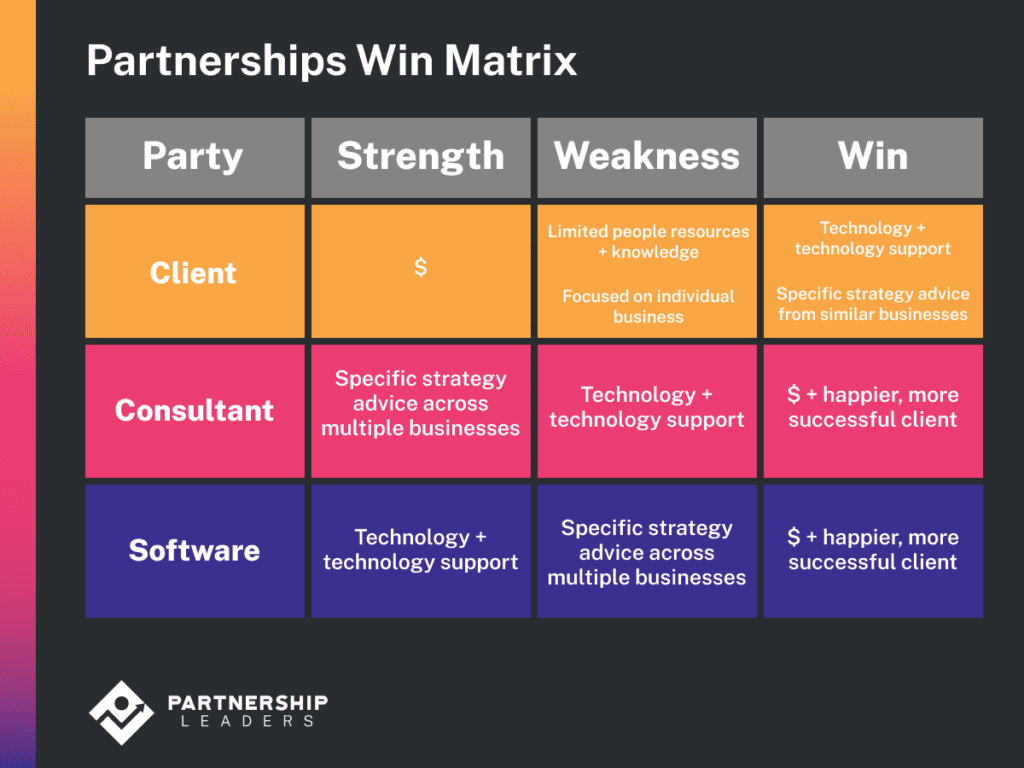You’ve probably heard the term win-win-win partnership or triple-win partnership thrown around. This is the holy grail of alliances. Even though they’re so important, many professionals forget to consider all three parties when forging partnerships.
In this article, I’m going to dive into win-win-win partnerships, including why they’re so important, best practices to keep in mind as you’re developing your partner strategy, and a framework you can use to ensure everyone is winning.
What is a win-win-win partnership?
A win-win-win partnership is one where, quite literally, everyone in the interaction wins. The three core winners would be first and foremost, the client, then the partner, and then my organization. That order is key. For any solution, the client should always be the focal point. You should never partner just to sell a product, your client needs to be the main focus. If they don’t have a win in the partnership, it’s not worth exploring.
A win can be defined as a net-positive effect and the exchange of value. Everyone fills the gap of others and benefits from the interaction so each party can win together. If you’re not looking for win-win-win scenarios in a partnership, it’s going to be wasting someone’s time. Although one party may be benefitting from the interaction, that doesn’t mean they’ll stay on as a partner or a customer.
For example, If I’m a software company — let’s use Mailshake, a sales engagement platform — then I do one thing really well, and that’s the technology piece. What I don’t do well is give specific, targeted expertise to individual organizations. I can give general advice and provide a lot of value in my content, but I can’t give individual businesses the best strategic advice.
If I’m a partner — let’s say a sales consultant — then I also do one thing really well: giving advice on individual and individual business sales strategies that can be targeted and specific. What I don’t do well is developing software or providing a technical service. As a result, I can only guide clients to the best, recommended software.
If I’m a client — let’s say I’m a salesperson — then I do one thing really well, and that’s my job (it’s also my primary focus). What I don’t do well is develop software, nor do I hold all of the knowledge of organizations similar to me. I can pay money for these things though. So in this scenario, we have three parties. Each has a gap that the others help fill.
How can you ensure everyone wins in a partnership?

You should already start building out the win-win-win scenarios at the early stages of conceptualizing what a partnership could look like. For me, I physically layout who is winning and how they’re winning, including how my business wins, how the partner wins, and how the client wins. Grab my win matrix template to follow along.
If you consider triple-win partnerships from the conception of your ideal partner profile, that will help guide you toward what partners you should work with. If you find there’s no value in partnering, then it needs to become a lower priority. On the other hand, if there are many wins that can happen in a partnership when conceptualized, it should be a priority.
In essence, you want to put pen to paper and physically (or virtually) build out the win matrix. Defining your win matrix is vital in the understanding of what partners we go after and why we go after them. Then, you can point your team to the benefits — How do you help clients? How do partners help clients? Not only will this activity help you find wins and determine where to dedicate your time, but it also helps new partner hires to hit the ground running, increases cross-functional understanding, and drives team buy-in.
What questions should you ask during the prospecting phase?

When you’re in early talks with a prospective partner, you’ll want to ask a few key questions to ensure the relationship is a good fit for both of you. It’s great to start by asking about their goals. Start with their overall organizational goals and current focuses. Then, ask what their organization hopes to achieve through the relationship and what they want to get out of it personally. From here, it’s crystal clear on how and where you can align both organizations’ goals.
Next, you should ask about what kind of partnerships they’ve done in the past. That will help you understand where you each have experiences and, ultimately, who will take the lead. By asking questions about previous partnerships and previous engagement, you’ll be able to begin determining whether or not they’re a good fit. You only have so many hours, so if you’re okay taking the lead, you should know you’ll need to do that. If you’re not okay, you need to protect your time. You need to make sure you’re making the most out of both parties’ time no matter what.
What will you gain from triple-win partnerships?
Triple-win partnerships are essential for a strong, successful partner ecosystem. Win-win-win partnerships drive higher closed-won ratios for sales, longer lifetime clients, higher renewal rates for success teams, and more positive reviews for your internal stakeholders. For the partnership organization, you gain more loyal & collaborative partners, better overall relationships, and more.
Develop Your Win-win-win Partnerships
You, too, can develop win-win-win partnerships. Enter each relationship understanding how the partnership will benefit each party, remembering to put your client first. Ask probing questions about your partner’s goals and experiences to determine if the partnership will be a good fit, and prioritize your partners accordingly. Grab my partner win matrix to use when scoping out your partnerships.
Partnership Leaders connects hundreds of partnership professionals in their online community, providing tactical resources, events, and connections. Apply to join Partnership Leaders.
Join The 1850+ Leaders Transforming Partnerships
As a member of Partnership Leaders you will:
- Build and learn with the top partner people at the best companies around the world.
- Increase your impact and accelerate your career with proven resources, tools, and best practices.
- Grow a network of peers, partners, and advisors with common objectives.

